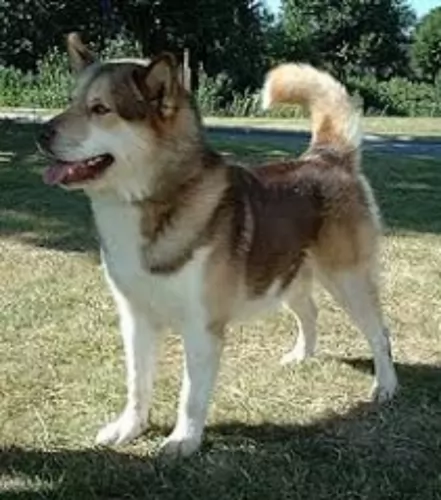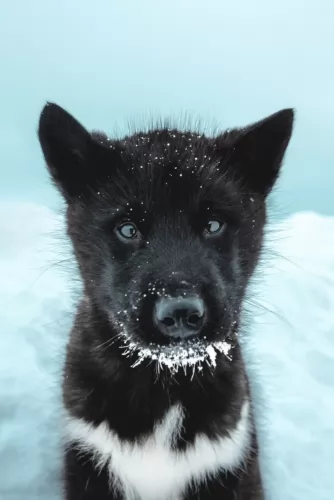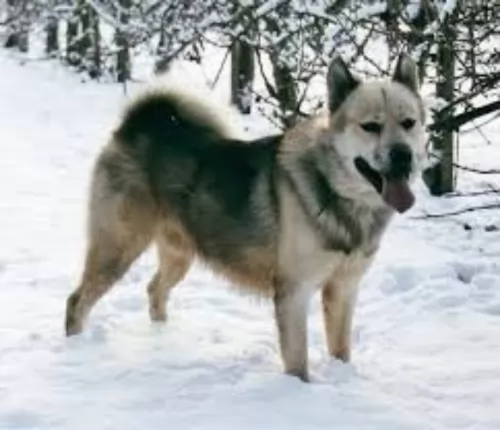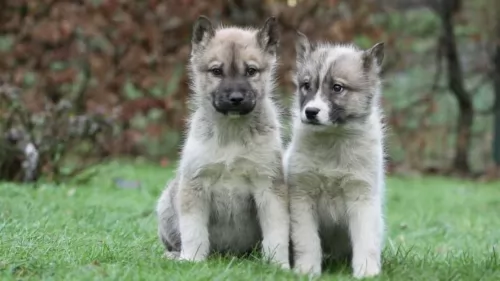 Petzlover
Petzlover Greenland Dog is originated from Greenland but Queensland Heeler is originated from Australia. Greenland Dog may grow 17 cm / 7 inches higher than Queensland Heeler. Greenland Dog may weigh 13 kg / 29 pounds more than Queensland Heeler. Both Greenland Dog and Queensland Heeler has almost same life span. Both Greenland Dog and Queensland Heeler has almost same litter size. Greenland Dog requires Moderate Maintenance. But Queensland Heeler requires Low Maintenance
Greenland Dog is originated from Greenland but Queensland Heeler is originated from Australia. Greenland Dog may grow 17 cm / 7 inches higher than Queensland Heeler. Greenland Dog may weigh 13 kg / 29 pounds more than Queensland Heeler. Both Greenland Dog and Queensland Heeler has almost same life span. Both Greenland Dog and Queensland Heeler has almost same litter size. Greenland Dog requires Moderate Maintenance. But Queensland Heeler requires Low Maintenance
 The Greenland dog is an ancient breed of dog hailing from Greenland. The dog was brought to North American from Siberia hundreds of years ago. In fact the very first dogs arrived in the Americas some 12,000 years ago.
The Greenland dog is an ancient breed of dog hailing from Greenland. The dog was brought to North American from Siberia hundreds of years ago. In fact the very first dogs arrived in the Americas some 12,000 years ago.
The Greenland Dog isn’t recognized by the AKC but it is recognized by a number of other groups. While the Greenland Dog is valued in Greenland, it isn't particularly well known in other parts of the world.
 Another name for Queensland Heeler is Australian Cattle Dog or Blue Heeler.
Another name for Queensland Heeler is Australian Cattle Dog or Blue Heeler.
These dogs have always been known for herding cattle. The term ‘Heeler’ comes from the dog’s working style – nipping and biting at the cattle’s hooves.
He was was an Australian cattle dog for Australian settlers in the 1800s. It is believed that Thomas Hall created one of the foundations of the Australian Cattle Dog breed by crossing crossing sheepdogs with Dingos.
The Blue-colored dogs have been the most popular, being known as the Blue Heeler.
 The Greenland Dog is a heavily built dog, and between the males and females, this medium to large sized dog can be 51 – 68cm in height and weigh 30 – 35kg.
The Greenland Dog is a heavily built dog, and between the males and females, this medium to large sized dog can be 51 – 68cm in height and weigh 30 – 35kg.
He has the typical slanted eyes of the husky-type dogs with a keen, alert expression in them. He has small triangular erect ears. The long, bushy tail of the dog is curled over the back of the dog.
The coat is short to medium length and has 2 layers with the outer layer being fairly coarse. The double coat is thick and shortish but also stand-offish, meaning the hair doesn’t lie flat against the dog’s body. Color of the fur is a mix of cream, beige, white, tan, black, grey or silver.
As a working dog, the Greenland Dog is known for its strength, its boisterous nature and speed. Because its a dog that has worked as a pack, it wants a firm, patient, fair, confident owner to bring out the best in him. Being intelligent, independent and work-orientated, it is perhaps not a great choice for the first-time dog owner who may be out of their realm with the demands of these high-energy dogs.
The dog is independent, but he is quite capable of forming a strong, loving bond with his owner. This is certainly a dog that is never going to thrive if he has to lie around the house all day – he is an active dog who wants a task to do and he is going to need plenty of daily exercise.
They’ve always had active lives pulling sleds or hunting for seals and he craves this busy, active lifestyle. He is the kind of dog that shouldn’t live in the city with a tiny garden unless he has an owner who takes time to walk him and exercise him vigorously. He is a dog that will require training and socialization.
 The Queensland Heeler is a medium sized dog that stands between 43 and 51cm in height, both male and female. The dog weighs in the region of 15 to 22kg.
The Queensland Heeler is a medium sized dog that stands between 43 and 51cm in height, both male and female. The dog weighs in the region of 15 to 22kg.
He has a short double coat with colors being blue, mottled blue and also red speckled. You’ll also find black and tan coloring on this active dog.
He is strong, lean and muscular with medium sized ears that are erect. The eyes are dark and alert, the legs straight and strong. The tail can be docked or left long.
The Australian Cattle Dog is a high-energy working dog that you won’t easily find lying around. The alert eyes are consistently looking around for action and he can’t be bored otherwise he could resort to digging or other destructive behavior.
He is loving to his entire human family, but being particularly attached to just one family member. He is also protective, taking his guarding role of his family seriously.
He gets on well with children and other pets but you’ve just got to keep your eyes on him around children as when excited he can give a nip or two.
Training and socialization will be important for this dog, particularly because he can be strong-headed, willful and stubborn.
 Bred as a working dog, the Greenland Dog, native to Greenland is a high energy dog who is boisterous, lively and social. With training and socialization, he becomes an obedient, loyal and devoted pet.
Bred as a working dog, the Greenland Dog, native to Greenland is a high energy dog who is boisterous, lively and social. With training and socialization, he becomes an obedient, loyal and devoted pet.
While he is quite capable of being an awesome domesticated pet, he is essentially a working dog, loving having to be part of a very active lifestyle. He may not be the best pet for a first time owner or a home with small children. This is because he isn't your cuddly, lying-around-the-house, playmate kind of pet. He wants a home and owner similar to himself – strong, active, energetic, bold, independent, strong-willed and firm, and when he gets this, he becomes the splendid pet he is so well known for.
 Active, intelligent, feisty, brave, playful, loving – these are just some of the wonderful characteristics you get when you bring a Queensland Heeler into your home.
Active, intelligent, feisty, brave, playful, loving – these are just some of the wonderful characteristics you get when you bring a Queensland Heeler into your home.
True, he is independent, self-willed and stubborn, but training and socialization can take away all the rough edges.
He forms a strong bond with his human owner, and once you’ve had one of these amazing dogs in your life, you’ll be convinced that dogs are truly man’s best friend.
 Your Greenland dog can battle with eye problems such as progressive retinal atrophy, hereditary or juvenile cataracts and corneal dystrophy. Eye diseases like this can cause a host of problems for your pet and should receive immediate veterinary attention.
Your Greenland dog can battle with eye problems such as progressive retinal atrophy, hereditary or juvenile cataracts and corneal dystrophy. Eye diseases like this can cause a host of problems for your pet and should receive immediate veterinary attention.
Cataracts in dogs are a common problem affecting the eyes of dogs, with there being different forms and causes.The age at which your pet develops cataracts is important for identifying the type of cataract it is because it will give the vet an idea if the cataracts are an hereditary trait in certain dog breeds.
Nearly every dog can battle with hip dysplasia and it can be a serious concern for active canines such as the Greenland dog.
This joint and bone ailment can start manifesting itself as early as 4 months of age with your pet. This dysplasia occurs when the head of the femur doesn't fit into the pelvic joint the way it should. It can lead to pain, arthritis and lameness with your dog.
 Australian Cattle Dogs are healthy. Every dog, even the most healthiest breeds, can succumb to some of the common dog illnesses there are.
Australian Cattle Dogs are healthy. Every dog, even the most healthiest breeds, can succumb to some of the common dog illnesses there are.
This is an inherited condition, so if you’re looking for a puppy, be careful about the breeder you buy from.
This is another inherited condition where the thighbone of the dog doesn't fit properly into the hip joint. Your dog is usually so active but with this problem he may well be in pain and actually be lame. Your pet can even develop arthritis . The idea is to get your pet to the vet because it can be unbearable to see him in pain and unable to get around.
This eye disease can mean deterioration of the retina. You'll recognize the signs when you see your dog unable to navigate around your home during the night. He is night blind but later on he can’t see during the day either.
 As a medium- to large-sized dog breed, the Greenland Dog will require a high-quality commercial dog food if that is what you will be feeding him. The top quality brands have the right mix of vitamins and minerals in them for health.
As a medium- to large-sized dog breed, the Greenland Dog will require a high-quality commercial dog food if that is what you will be feeding him. The top quality brands have the right mix of vitamins and minerals in them for health.
However, it is wise to ensure that such an active dog breed gets his quota of raw meat in too. He has been used to eating fish and seal meat and will require this raw diet too. Sometimes if you cook rice, chicken and vegetables, you can add this into his kibble too.
Greenland Dogs need to be groomed at least twice a week to keep the thick coat in tip top condition. He sheds throughout the year.
He will also require you brushing his teeth to get rid of plaque which can cause a host of health issues. You get special toothpaste and toothbrush for dogs. His teeth should be brushed 2 or 3 times a week.
Make sure you give your high-energy Greenland Dog the right dose of exercise. He is intelligent too so he needs walks, games and other activities that contribute towards his physical and mental wellbeing.
He will do well on large properties or farms but won't do well where the space is tiny and where the owners are inactive couch potatoes.
Be careful too that the Greenland Dog isn't exercised immediately after eating as this puts him in danger of developing bloat.
 To cope with his life on the Australian Outback, the Queensland Heeler is known to be a low maintenance dog.
To cope with his life on the Australian Outback, the Queensland Heeler is known to be a low maintenance dog.
The thick coat does shed and it can get dusty so a good brush twice a week is all that is basically required for this dog. If his nails don’t wear down naturally, you will need to have them trimmed. As with every dog, you will need to give attention to his ears and teeth.
This is an extremely active dog. He is going to be needing both mental and physical stimulation to avoid boredom, after all he is used to an active lifestyle herding cattle. Hikes, swimming, running – you name it – he’ll join you with all your activities.
Your Queensland Heeler is such a vibrant dog, full of the joys of living, and you want to ensure he has good food to eat to ensure he stays like that.
For convenience you get some excellent commercially manufactured dog foods. Your Blue Heeler is such a wonderful companion dog that you want to spoil him a bit and give him some delicious home-made food too. Boiled chicken, brown rice or pasta and spinach, sweet potatoes and carrots are a healthy choice for your pet – plain and simple just like dogs love it. Chop it up and add it into the high quality dry kibble a couple of times a week.
Some raw meat added in from time to time will help his skin and coat remain healthy. Never leave him without a constant source of fresh, cool water.